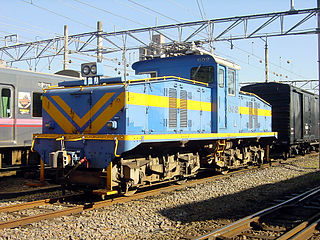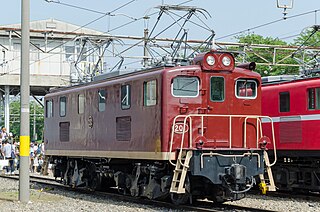
The Chichibu Main Line is a railway line in Japan, owned by the private railway operator Chichibu Railway, linking Hanyū and Mitsumineguchi, both in Saitama Prefecture.
The Mizushima Rinkai Railway is a third-sector railway company based in Kurashiki, Okayama, Japan. The company took over operation of three former Kurashiki City Transportation Bureau lines in 1970. It mainly transports freight for the industrial area around the Port of Mizushima, but also operates a passenger service on the Mizushima Main Line

The Chichibu Railway 7000 series (秩父鉄道7000系) is an electric multiple unit (EMU) train type for local services on the Chichibu Main Line operated by the private railway operator Chichibu Railway in Japan since March 2009.

The Kashima Rinkai Railway Ōarai Kashima Line is a 53.0 km Japanese railway line in Ibaraki Prefecture, which connects Mito Station in Mito with Kashima Soccer Stadium Station in Kashima. It is owned and run by the third-sector railway operating company Kashima Rinkai Railway (KRT).

The Chichibu Railway 7500 series (秩父鉄道7500系) is an electric multiple unit (EMU) train type for Chichibu Main Line local services on the Chichibu Main Line operated by the private railway operator Chichibu Railway in Japan since March 2010.

The Chichibu Railway 1000 series (秩父鉄道1000系) was an electric multiple unit (EMU) train type for local services operated by Chichibu Railway in Japan from 1986 until March 2014.

The Chichibu Railway 5000 series (秩父鉄道5000系) is an electric multiple unit (EMU) train type operated by the private railway operator Chichibu Railway on Chichibu Main Line local services in Japan.

The Chichibu Railway 6000 series (秩父鉄道6000系) is an electric multiple unit (EMU) train type for express services on the Chichibu Main Line operated by the private railway operator Chichibu Railway in Japan since 2006.

The Tobu 30000 series is a DC electric multiple unit (EMU) commuter train type operated by the private railway operator Tobu Railway in Japan since 1997. Initially formed as six-car and four-car sets, sets are mostly formed as permanently coupled ten-car formations since 2011.

The Meitetsu DeKi 600 was a Bo-Bo wheel arrangement electric locomotive type operated by private railway operator Nagoya Railroad (Meitetsu) in Japan from 1943 until 2015.

The Chichibu Railway 7800 series (秩父鉄道7800系) is a 2-car electric multiple unit (EMU) train type operated by the Japanese private railway operator Chichibu Railway on Chichibu Main Line local services since 16 March 2013.

The Keihan 5000 series is an electric multiple unit (EMU) commuter train type operated by the private railway operator Keihan Electric Railway in Japan since 1970.

The Chichibu Railway Class DeKi 200 (秩父鉄道デキ200形) is a Bo-Bo wheel arrangement DC electric locomotive type operated by the private railway operator Chichibu Railway in Saitama Prefecture, Japan, since 1963.

The Seibu 3000 series (西武3000系) was an electric multiple unit (EMU) train type operated by the private railway operator Seibu Railway on commuter services in the Tokyo area of Japan from 1982 until 2014.

The South Hokkaido Railway Company is a third-sector railway company based in Hakodate, Hokkaido, Japan.

The Toei 9000 series (東京都交通局9000形) is a tramcar type operated by Tokyo Metropolitan Bureau of Transportation (Toei) on the Toden Arakawa Line in Tokyo, Japan, since 2007.

The Kominato Railway KiHa 200 series is a single-car diesel multiple unit (DMU) train type operated by the third-sector railway operator Kominato Railway on the 39.1 km (24.3 mi) Kominato Line between Goi and Kazusa-Nakano in Chiba Prefecture, Japan, since 1962. As of 1 April 2016, all 14 of the Kiha 200 series cars built are in service.

The Tokyu 7700 series is an electric multiple unit (EMU) train type operated by the private railway operator Tokyu Corporation on the Tokyu Ikegami and Tokyu Tamagawa lines in Japan from 1987 to 2018.




























